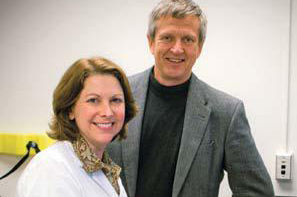Hendrik Viljoen, Ph.D., didn’t plan to tackle one of the world’s deadliest bacteria.
He was, after all, an engineer, not a clinical researcher.
But, Dr. Viljoen has developed new technologies that have the potential to diagnose tuberculosis (TB) in the developing world more quickly and more accurately than any test used today.
“It’s an engineering novelty,” said the professor, who has a joint appointment in UNMC’s Department of Internal Medicine – Infectious Diseases and the University of Nebraska-Lincoln’s Chemical and
Biomolecular Engineering Department. “When people move comfortably between disciplines they become more innovative.”
 |
Hendrik Viljoen, Ph.D. and Alison Freifeld, M.D. |
Since 2008, she has provided the medical expertise and collaborative laboratory studies that have resulted in clinical testing of the technology in Dr. Viljoen’s native South Africa.
“For more than 100 years, smear microscopy has been used to diagnose TB,” said Dr. Freifeld, professor of internal medicine/infectious diseases at UNMC. “We want to replace that with a 21st century technology that is adapted to the constraints of resource-poor areas of the world. It must be fast, simple and cheap.”
Smear microscopy has many constraints in the developing world, Dr. Viljoen said. Culture samples (sputum) are sent to the nearest large city with a lab and usually take six weeks. The test is time consuming, labor intensive and 60 percent sensitive at best.
|
Using their unique thermocycler, the PCR reaction takes less than 20 minutes and appears to be more sensitive than existing diagnostics.
The final version of the technology is expected to cost less than $10 a test and reduce staff demand and the infection risk of health care workers. Existing devices take two hours to diagnose, an $80,000 machine and costly reagents.
“The rapid PCR technology has been tested in South Africa and holds much promise as a point-of-care device for third-world countries,” said Michael Dixon, Ph.D., president of UNeMed Corporation, the technology transfer arm of UNMC. “It’s also generating revenue for the university.”